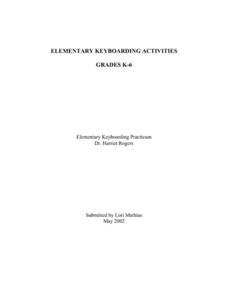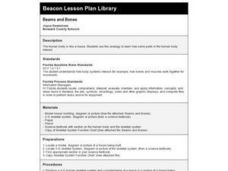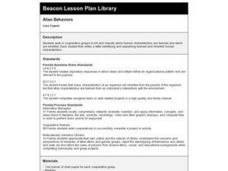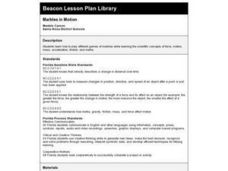Curated OER
Revised: Adventures in Earth Day: Why Do We Care About Our Environment? - Biology Teaching Thesis
To describe the ecological and aesthetic importance of the Potomac River, Middle schoolers name the ways in which the river's values are jeopardized and explain the purpose of Earth Day. They write a response to a newspaper article in a...
Curated OER
The Wonders of Water - Biology Teaching Thesis
Students name 3-5 aesthetic values of the Potomac River. They state the importance of water in their own words. Students describe what Earth Day is and why it is important. They list 5-7 ways that they can help minimize water pollution.
K12 Reader
The Scientific Method
Introduce the scientific method with a reading comprehension activity. Have kids read a few paragraphs that describe the process of making a hypothesis, gathering evidence, and taking notes that will support the experiment.
Curated OER
Principle of Art Balance
Reinforce a strong art vocabulary which can also apply to aspects of math and science. Kids read about various types of balance or symmetry found in art. They analyze three paintings based on vocabulary and read a how-to for creating...
Curated OER
Elementary Keyboarding Activities
Listen to the sound of children's fingers flying across their keyboards as they perform these fun typing lessons. From creating alphabet books and multimedia presentations to researching presidents and writing class newsletters, numerous...
Curated OER
Equivalent Fractions and Comparing Fractions
How can you tell if fractions have equal value? Use various collaborative activities to demonstrate the ways to determine whether or not fractions are equivalent.
California Education Partners
Follow the Water by Arthur Dorros
Assess scholars' reading and writing capabilities with an exam that challenges learners to respond to an informative text. Through note-taking and peer discussion, pupils analyze a passage from the story, Follow the Water from Brook to...
Curated OER
Rainforest Animals – Camouflage and Coloring for Protection
Students explain why animals need to blend in with their surrounding. In this environmental science instructional activity, students create moth paper models to simulate animals hidden in the rainforests. They make a bulletin board...
Curated OER
White-Tailed Deer
Young scholars investigate the importance of white-tailed deer and their impact on forest environments. They visit learning centers to simulate being a white-tailed deer and work in groups. After visiting a forest they share their...
Curated OER
Legend of the Indian Paintbrush
Third graders discuss the story read to them and explain the legend of the Indian Paintbrush. They study Indian sign language of 4 different topics and create a sentence using the sign lang. they just learned.
Curated OER
The Life Cycle of the Butterfly
Second graders study the life cycle of a butterfly by observing metamorphosis taking place in a butterfly pavilion. Students illustrate their understandings of the body parts of a caterpillar and butterfly, as well as the life cycle,...
Curated OER
It's Alive
First graders critically analyze living and nonliving objects, then develop a list of characteristics to classify objects on a science walk. They make a book to close out the lesson.
Curated OER
What On Earth
Students explore earth science through concept mapping, discussion, and self-discovery.
Curated OER
The Tadpole and the Frog
First graders examine the life cycle of the frog, and research frogs of the Nez Perce reservation and their requirements for survival. They observe the development of frog eggs and record their observations in science journals.
Curated OER
Beams and Bones
Fifth graders learn how parts of the human body interact and how bones and muscles work together.
Curated OER
Cellular Cellebrities
Sixth graders, in groups, learn the morphology and function of organelles within plant and animal cells.
Curated OER
Student Designed Investigations Part 2 – Testable Questions, Predictions, Materials and Procedures
Students create their own investigations. For this science experiments lesson, students use the steps of the scientific method to design an investigation. Students share their findings on a poster.
Curated OER
The Water Cycle and Clementine
Third graders sing a piggyback song to explore the parts of the water cycle and then illustrate and label the water cycle in their science journals.
Curated OER
Sunbeam Dining
Students learn at least two different things that animals eat, then construct a food chain and play a food chain game.
Curated OER
Over the Rainbow with Isaac Newton
Second graders study rainbows and do an interdisciplinary assignment that includes poetry and a science experiment.
Curated OER
Alien Behaviors
Second graders identify human characteristics and classify them as inherited traits or learned traits.
Curated OER
Properties of Waves
Third graders observe and investigate wave properties and compare the properties of particles and waves. They fill a pie pan half full with water, place a toothpick in the center of the pie pan, then drop a marble into the pan and...
Curated OER
Systems Working Together
Fourth graders practice reading in the content areas (science) in order to explore the interdependence of the body systems. They answer written questions after reading.
Curated OER
Marbles in Motion
Fourth graders explore how to play marbles while learning the scientific concepts of force, motion, mass, acceleration, friction, and inertia.

























